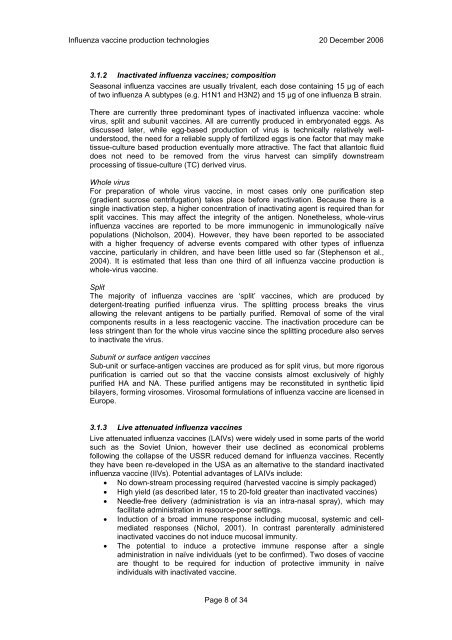A review of production technologies for ... - World Health Organization
A review of production technologies for ... - World Health Organization
A review of production technologies for ... - World Health Organization
You also want an ePaper? Increase the reach of your titles
YUMPU automatically turns print PDFs into web optimized ePapers that Google loves.
Influenza vaccine <strong>production</strong> <strong>technologies</strong> 20 December 2006<br />
3.1.2 Inactivated influenza vaccines; composition<br />
Seasonal influenza vaccines are usually trivalent, each dose containing 15 µg <strong>of</strong> each<br />
<strong>of</strong> two influenza A subtypes (e.g. H1N1 and H3N2) and 15 µg <strong>of</strong> one influenza B strain.<br />
There are currently three predominant types <strong>of</strong> inactivated influenza vaccine: whole<br />
virus, split and subunit vaccines. All are currently produced in embryonated eggs. As<br />
discussed later, while egg-based <strong>production</strong> <strong>of</strong> virus is technically relatively wellunderstood,<br />
the need <strong>for</strong> a reliable supply <strong>of</strong> fertilized eggs is one factor that may make<br />
tissue-culture based <strong>production</strong> eventually more attractive. The fact that allantoic fluid<br />
does not need to be removed from the virus harvest can simplify downstream<br />
processing <strong>of</strong> tissue-culture (TC) derived virus.<br />
Whole virus<br />
For preparation <strong>of</strong> whole virus vaccine, in most cases only one purification step<br />
(gradient sucrose centrifugation) takes place be<strong>for</strong>e inactivation. Because there is a<br />
single inactivation step, a higher concentration <strong>of</strong> inactivating agent is required than <strong>for</strong><br />
split vaccines. This may affect the integrity <strong>of</strong> the antigen. Nonetheless, whole-virus<br />
influenza vaccines are reported to be more immunogenic in immunologically naïve<br />
populations (Nicholson, 2004). However, they have been reported to be associated<br />
with a higher frequency <strong>of</strong> adverse events compared with other types <strong>of</strong> influenza<br />
vaccine, particularly in children, and have been little used so far (Stephenson et al.,<br />
2004). It is estimated that less than one third <strong>of</strong> all influenza vaccine <strong>production</strong> is<br />
whole-virus vaccine.<br />
Split<br />
The majority <strong>of</strong> influenza vaccines are ‘split’ vaccines, which are produced by<br />
detergent-treating purified influenza virus. The splitting process breaks the virus<br />
allowing the relevant antigens to be partially purified. Removal <strong>of</strong> some <strong>of</strong> the viral<br />
components results in a less reactogenic vaccine. The inactivation procedure can be<br />
less stringent than <strong>for</strong> the whole virus vaccine since the splitting procedure also serves<br />
to inactivate the virus.<br />
Subunit or surface antigen vaccines<br />
Sub-unit or surface-antigen vaccines are produced as <strong>for</strong> split virus, but more rigorous<br />
purification is carried out so that the vaccine consists almost exclusively <strong>of</strong> highly<br />
purified HA and NA. These purified antigens may be reconstituted in synthetic lipid<br />
bilayers, <strong>for</strong>ming virosomes. Virosomal <strong>for</strong>mulations <strong>of</strong> influenza vaccine are licensed in<br />
Europe.<br />
3.1.3 Live attenuated influenza vaccines<br />
Live attenuated influenza vaccines (LAIVs) were widely used in some parts <strong>of</strong> the world<br />
such as the Soviet Union, however their use declined as economical problems<br />
following the collapse <strong>of</strong> the USSR reduced demand <strong>for</strong> influenza vaccines. Recently<br />
they have been re-developed in the USA as an alternative to the standard inactivated<br />
influenza vaccine (IIVs). Potential advantages <strong>of</strong> LAIVs include:<br />
• No down-stream processing required (harvested vaccine is simply packaged)<br />
• High yield (as described later, 15 to 20-fold greater than inactivated vaccines)<br />
• Needle-free delivery (administration is via an intra-nasal spray), which may<br />
facilitate administration in resource-poor settings.<br />
• Induction <strong>of</strong> a broad immune response including mucosal, systemic and cellmediated<br />
responses (Nichol, 2001). In contrast parenterally administered<br />
inactivated vaccines do not induce mucosal immunity.<br />
• The potential to induce a protective immune response after a single<br />
administration in naïve individuals (yet to be confirmed). Two doses <strong>of</strong> vaccine<br />
are thought to be required <strong>for</strong> induction <strong>of</strong> protective immunity in naïve<br />
individuals with inactivated vaccine.<br />
Page 8 <strong>of</strong> 34

















